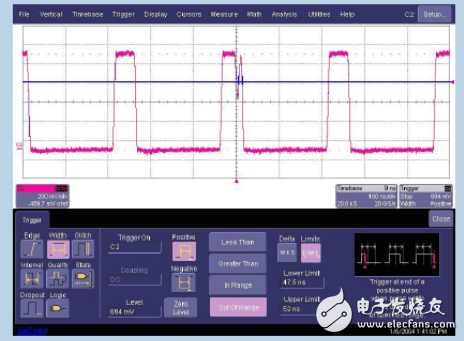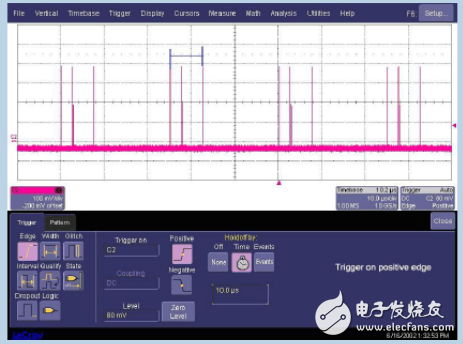The memory of any oscilloscope is limited, so all oscilloscopes must use triggers. Triggering is an event that the oscilloscope should find that the user is interested in. In other words, it is what the user wants to look for in the waveform. A trigger can be an event (that is, a problem in a waveform), but not all triggers are events. Examples of triggers include edge triggering, glitch triggering, and digital pattern triggering.
The reason the oscilloscope must use the trigger is because its memory has a limited capacity. For example, the Agilent 90000 Series oscilloscope has a memory depth of 2 billion samples. However, even with such a large amount of memory, the oscilloscope needs some events to distinguish which 2 billion samples need to be displayed to the user. Although the 2 billion samples sound very large, this is not enough to ensure that the oscilloscope memory captures events of interest.
The oscilloscope's memory can be thought of as a conveyor belt. Whenever a new sample is taken, the sample is stored in memory. When the memory is full, the oldest samples are deleted to save the most recent samples. When a trigger event occurs, the oscilloscope captures enough samples to store the trigger event at the location required by the memory (usually in the middle) and then displays the data to the user.
Oscilloscope trigger functionThere are two main points in the trigger function of the oscilloscope. First, isolate the events of interest. Second, the waveform is synchronized, or the waveform is displayed stably.
Isolating an event of interest, that is, an event that is isolated at the trigger point is a signal that satisfies the trigger condition. As shown in the following figure, the event isolated at the trigger point is a pulse width that is always less than 47.5 ns or greater than 52 ns, which is calculated as the time interval at the intersection of the trigger level crossing the pulse width waveform at the trigger point.

Isolate events of interest
Synchronous waveforms are a way to find a way to make the waveform no longer "shake", that is, to find out the regularity of the signal to synchronize the signal. As shown in Figure 2, there are four pulses in each group of data packets. These four pulses are not equally time-interval. If triggered by a rising edge, the waveforms cannot be synchronized, visually “shakingâ€, but each group The data packets arrive at equal time intervals. If the rising edge of the first pulse of each group of packets is used as the trigger source, the waveform can be stably displayed. Therefore, the edge delay trigger can be used. After the previous rising edge arrives, the delay is triggered for a period of time and the next rising edge is triggered. In the above example, the delay time is the blue time interval portion of the identifier.

Synchronization signal enables stable waveform display
Thyristor module is one of the most commonly used semiconductor devices because of its small size, simple structure and strong function.This device has been widely applied in various kinds of electronic equipment and electronic products, used as a rectifier, inverter, frequency, voltage regulator, contactless control of motor speed, motor excitation, non-contact switch and the power control, etc.
Thyristor Module,High Current Thyristor Module,Air Cooling Thyristor Module,Standard Voltage Thyristor Module
YANGZHOU POSITIONING TECH CO., LTD. , https://www.cnfudatech.com
